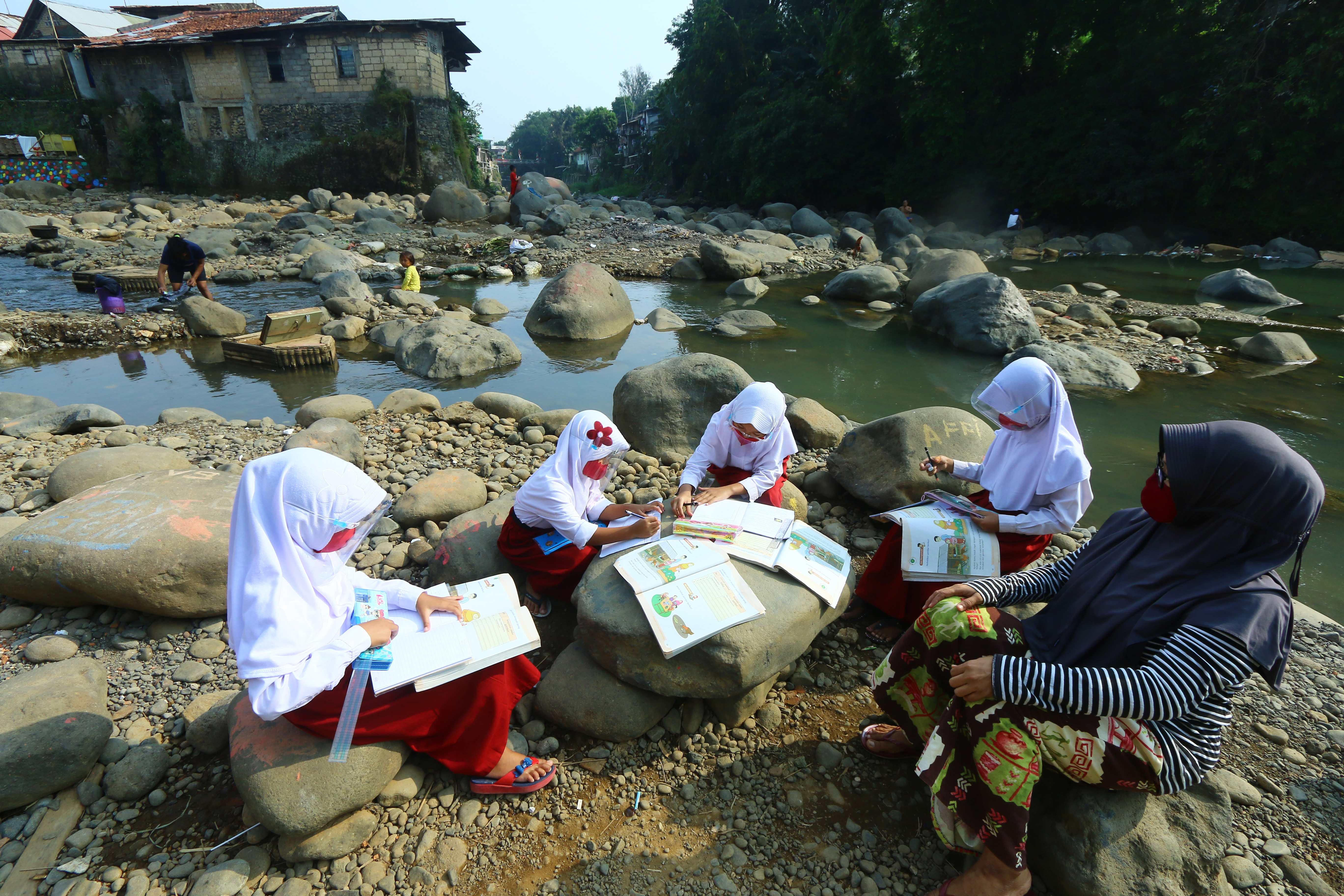
Children studying together along the Ciliwung River in the village of Kebon Jukut, Bogor City while most Indonesian schools were shut during the coronavirus pandemic.
Andi M Ridwan | Opn Images | Barcroft Media via Getty Images
Indonesian students — already lagging their global peers in some areas — could lose the opportunity to catch up as their access to education is hit by prolonged school closures due to the coronavirus pandemic, a study found.
Most schools in Indonesia have remained shut since March as authorities struggle to contain the fast-spreading virus. The government’s attempt to reopen some schools has reportedly been opposed by teachers and health experts, who argued that the move could worsen the country’s outbreak.
Indonesia, the world’s fourth most populous country, has reported more than 157,800 cases of the coronavirus disease or Covid-19 — the second highest cumulative infections in Southeast Asia, according to data compiled by Johns Hopkins University. But the country’s death toll of over 6,800 is the region’s largest, the data showed.
… school closure poses a significant risk that the little learning that Indonesian students gain in school may diminish.
ISEAS-Yusof Ishak Institute
The World Health Organization, in a situation report earlier this month, cited data that showed children ages 9 to 14 accounted for 6.8% of total reported cases in Indonesia. That’s “well above” the global average of 2.5%, it said.
“The figure could rise if face-to-face lessons resumes,” the WHO warned.
But for a country with already “low and stagnant” education quality, keeping schools shut will hold back Indonesia’s nearly 69 million students in their learning, according to a report published by Singaporean think tank ISEAS-Yusof Ishak Institute.
“Prior to the school closure, Indonesia’s education quality could already be characterized as low and stagnant,” read the report released last week. It noted that performance of the country’s 15-year-olds in the Programme for International Student Assessment, or PISA, “had not progressed much between 2003 and 2018.”
“Therefore, school closure poses a significant risk that the little learning that Indonesian students gain in school may diminish,” it added.
PISA is a global study by the Organisation for Economic Co-operation and Development. Conducted every three years, the study compares the performance of 15-year-olds around the world in areas such as reading, mathematics and science — with the results commonly used by policymakers to design education policies.
Reduced access to education
The report by ISEAS-Yusof Ishak Institute analyzed the results from ten surveys conducted between April and June this year to understand how learning among Indonesian students is affected by the closure of schools.
The surveys, carried out by various Indonesian and international agencies, interviewed school principals, teachers and students across education levels, as well as parents of school-aged children.
ISEAS made the following observations based on the survey findings:
- An estimated 60% to 70% of teachers interact directly with students or through the parents during school closures to provide feedback on learning. Many of those teachers are from urban areas with students from middle-upper income families;
- Children from families of a higher socioeconomic status with better-educated parents appear to adapt better to studying from home. But most students in the country have less educated parents;
- Around half of the teachers failed to adapt the curriculum based on students’ learning level, which is more critical when teaching remotely. That will disproportionately affect “low achieving students,” who may find it hard to catch up as the curriculum progresses;
- While 90% of teachers received “operational” support such as allowance for internet expenses, only 20% received academic support that included additional training.
The think tank pointed out that most of the surveys relied heavily on online responses, so their results may be skewed toward those with internet connections.
Only around 40% of Indonesians have internet access, most of them in urban areas such as capital city Jakarta, said ISEAS. That also implies that while schools are closed, “children in rural Indonesia with no access to internet connections face a severe limitation in receiving education services,” it said.
“The larger implication is that studying from home is unlikely to be effective in Indonesia,” it added.
Addressing ‘learning inequalities’
Still, the analysis pointed to a likely widening in “learning inequalities” in Indonesia as a result of school closures, said ISEAS. Some students may never make up for the loss in learning during the pandemic, added the think tank.
“In the long-term, these inequalities would translate into widening socioeconomic inequalities,” it said.
The think tank outlined in its report how Indonesia could address the problem. First, the Ministry of Education and Culture should “quickly” find ways to measure students’ ability during school closures to gauge the severity of learning losses. That should be done “periodically,” such as every two months, according to the report.
Next, the ministry should encourage teachers to assess students’ learning levels from time to time, and then adapt their lessons accordingly, said ISEAS. The ministry can persuade teachers to try a method they’re most comfortable with for now, before giving them additional training when the pandemic has abated, the think tank explained.
Source: CNBC
